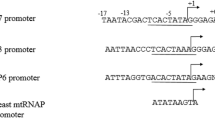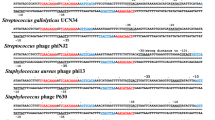Summary
The transcription pattern of bacteriophage Mu has been studied with the use of Mu-1 cts62, a thermo-inducible derivative of wild-type Mu. The rate of transcription at various times after induction was measured by pulse-labeling the RNA during synthesis and determining the fraction of Mu-specific RNA by hybridization with the separated strands of Mu-DNA. Transcription was found to take place predominantly from the heavy strand of Mu-DNA, as was found previously by Bade (1972). A study of the kinetics of this process revealed four phases. Initially after the induction the rate of transcription increases and reaches a maximum after four minutes. In the second phase during five minutes the rate falls down. During the third phase, up to 25 minutes after induction, the rate of transcription rises slowly, followed by a very rapid increase in the final phase, at the end of the lytic cycle. Phage Mu can be integrated in the host chromosome in two opposite orientations. The strand specificity, rate and time-course of transcription appeared not to be influenced by the orientation. The presence of chloramphenicol during the induction of the phage does not have an effect on the initial phase of transcription, but it prevents the decrease in the second phase. This suggests that in the early phase a Mu-specific protein is synthesized which acts as a negative regulator of trancription. In non-permissive strains, lysogenic for a phage with an amber mutation in gene A or B, the transcription during the first and the second phase is the same as with wild-type phage; in the third phase, however, there is much less transcription than with wild type phage, whereas in the final phase the increase of the transcription rate is completely absent.
Control experiments showed that DNA synthesis does not take place when a non-permissive strain is infected with a phage with an amber mutation in gene A or B. Therefore we conclude that the products of the genes A and B are required, directly or indirectly, for the autonomous replication of phage DNA. Since these amber mutants are also impaired in the integration process, we conclude that the genes A and B code for regulator proteins with a crucial role in the development of bacteriophage Mu.
Similar content being viewed by others
References
Abelson, J., Boram, W., Bukhari, A., Faelen, M., Howe, M., Metlay, M., Taylor, A., Toussaint, A., Van de Putte, P., Westmaas, G., Wijffelman, C.: Summary of the genetic mapping of prophage Mu. Virology 54, 90–92 (1973)
Bade, E.: Asymmetric transcription of bacteriophage Mu-1. J. Virol. 10, 1205–1207 (1972)
Bøvre, K., Szybalski, W.: Multistep DNA-RNA hybridization techniques. Methods Enzymol. 21, 350–383 (1971)
Boram, W., Abelson, J.: Bacteriophage Mu integration: on the orientation of the prophage. Virology 54, 102–108 (1973)
Bukhari, A., Metlay, M.: Genetic mapping of prophage Mu. Virology 54, 109–116 (1973)
Bukhari, A., Zipser, D.: Random insertion of Mu-1 DNA within a single gene. Nature (Lond.) New. Biol. 236, 240–243 (1972)
Daniell, E., Abelson, J., Kim, J., Davidson, N.: Heteroduplex structures of bacteriophage Mu DNA. Virology 51, 237–249 (1973)
Daniell, E., Roberts, R., Abelson, J.: Mutations in the lactose operon caused by bacteriophage Mu. J. molec. Biol. 69, 1–8 (1972)
Faelen, M., Toussaint, A.: Isolation of conditional defective mutants of temperate phage Mu-1 and deletion mapping of the Mu-prophage. Virology 54, 117–124 (1973)
Glickman, B. W., Walker, K. J., Rörsch, A.: The repair of 32P decay-damaged phage λ in various radiation-sensitive strains of E. coli K12. Mutation Res. 14, 265–270 (1972)
Gottesman, M., Yarmolinsky, M.: Integration negative Mutants of bacteriophage Lambda. J. molec. Biol. 31, 487–505 (1968)
Howe, M.: Prophage deletion mapping of bacteriophage Mu-1. Virology 54, 93–101 (1973)
Hsu, M., Davidson, M.: Structure of inserted bacteriophage Mu-1 DNA and physical mapping of bacterial genes by Mu-1 DNA insertion. Proc. nat. Acad. Sci. (Wash.) 69, 2823–2827 (1972)
Kourilsky, P., Marchaud, L., Sheldrick, P., Luzzati, D., Gros, F.: Studies on the messenger RNA of bacteriophage λ I. Various species synthesized early after induction of the prophage. Proc. nat. Acad. Sci. (Wash.) 61, 1013–1022 (1968)
Lindquist, B.: Vegetative DNA of temperate Coliphage P2. Molec. gen. Genet. 110, 178–196 (1971)
Lindquist, B., Bøvre, K.: Asymmetric transcription of the coliphage P2 genome during infection. Virology 49, 690–699 (1972)
Lindquist, B., Sinsheimer, R.: The process of infection with bacteriophage ΦX 174. XV. Bacteriophage DNA synthesis in abortive infection with a set of conditional lethal mutants. J. molec. Biol. 30, 69–80 (1967)
Summers, W., Szybalski, W.: Totally asymmetric transcription of coliphage T7 in vivo: correlation with Poly G binding sites. Virology 34, 9–16 (1968)
Taylor, A.: Bacteriophage-induced mutation in E. coli. Proc. nat. Acad. Sci. (Wash.) 50, 1043–1051 (1963)
Torti, F., Barksdale, C., Abelson, A.: Mu-1 bacteriophage DNA. Virology 41, 567–568 (1970)
Toussaint, A., Faelen, M.: Connecting two unrelated DNA sequences with a Mu dimer. Nature (Lond.) New. Biol. 242, 1–4 (1973)
Van de Putte, P., Gruijthuijsen, M.: Chromosome-mobilization and integration of F-factors in the chromosome of RecA strains of E. coli under the influence of bacteriophage Mu-1. Molec. gen. Genet. 118, 173–183 (1972)
Vogel, H., Bonner, D.: Acetylornithase of Escherichia coli: partial purification and some properties. J. biol. Chem. 218, 97–106 (1956)
Wijffelman, C., Westmaas, G., Van de Putte, P.: Vegetative recombination of bacteriophage Mu-1. Molec. gen. Genet. 116, 40–46 (1972)
Wijffelman, C., Westmaas, G., Van de Putte, P.: Similarity of the vegetative and prophage map of bacteriophage Mu-1. Virology 54, 125–134 (1973)
Yamoto, K., Alberts, B.: Rapid bacteriophage sedimentation in the presence of polyethylene glycol and its application to large—scale virus purification. Virology 40, 734–744 (1970)
Author information
Authors and Affiliations
Additional information
Communicated by G. Bertani
Rights and permissions
About this article
Cite this article
Wijffelman, C., Gassler, M., Stevens, W.F. et al. On the control of transcription of bacteriophage Mu. Molec. Gen. Genet. 131, 85–96 (1974). https://doi.org/10.1007/BF00266145
Received:
Issue Date:
DOI: https://doi.org/10.1007/BF00266145




